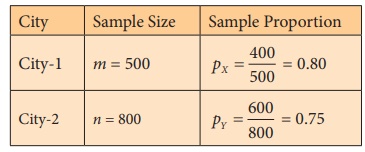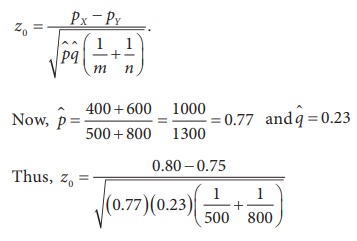Procedure Steps, Example Solved Problems | Statistics - Test of Hypotheses for Equality of Proportions of two Populations | 12th Statistics : Chapter 1 : Tests of Significance - Basic Concepts and Large Sample Tests
Chapter: 12th Statistics : Chapter 1 : Tests of Significance - Basic Concepts and Large Sample Tests
Test of Hypotheses for Equality of Proportions of two Populations
TEST OF HYPOTHESES FOR EQUALITY OF PROPORTIONS OF TWO POPULATIONS
Procedure:
Step 1 : Let PX and PY
denote respectively the proportions of Population-1 and Population-2 possessing
the qualitative characteristic (attribute) under study. Frame the null
hypothesis as H0: PX=PY and choose the
suitable alternative hypothesis from
(i) H1: PX≠ PY (ii) H1:
PX>PY (iii) H1: PX<PY
Step 2 : Let p X and pY denote
respectively the proportions of the samples of sizes m and n drawn from
Population-1 and Population-2 possessing the attribute, where m and n
are large (i.e.,
m ≥ 30 and n ≥ 30). Also, mpX > 5, m (1-
pX) > 5, npY > 5 and n (1 - pY
) > 5 .
Here, these two samples are assumed to be independent.
Step 3 : Specify the level of significance, α.
Step 4 : Consider
the test statistic  under H0. Here,
under H0. Here,  . The
approximate sampling distribution of the test statistic under H0 is the N(0,1)
distribution.
. The
approximate sampling distribution of the test statistic under H0 is the N(0,1)
distribution.
Step 5 : Calculate the value of Z for the given data as z0 =  .
.
Step 6 : Choose the critical value, ze,
corresponding to α and H1 from
the following table

Step 7 : Decide on H0 choosing the suitable rejection rule
from the following table corresponding
to H1.

Example 1.13
A study was conducted to investigate the interest of people living
in cities towards self-employment. Among randomly selected 500 persons from
City-1, 400 persons were found to be self -employed. From City -2, 800 persons
were selected randomly and among them 600 persons are self-employed. Do the
data indicate that the two cities are significantly different with respect to
prevalence of self-employment among the persons? Choose the level of
significance as
α = 0.05.
Solution:
Step1 : Let PX and PY
be respectively the proportions of self-employed people in City-1 and City-2.
Then, the null and alternative hypotheses are
Null hypothesis: H0 : PX = PY
i.e., there is no significant difference between the proportions of
self-employed people in City-1 and City-2.
Alternative hypothesis: H1 : PX ≠ PY
i.e., difference between the proportions of self-employed people in
City-1 and City-2 is significant. It is a two-sided alternative
hypothesis.
Step 2 : Data
The given sample information are

Here, m ≥
30, n ≥ 30, mpX
= 400 > 5, m(1− pX) = 100 > 5, npY
= 600 > 5 and n(1− pY) = 200
> 5.
Step 3 : Level of significance
α= 5%
Step 4 : Test statistic
The test statistic under the null hypothesis is

The
sampling distribution of Z under H0
is the N(0,1) distribution.
Step 5 : Calculation of Test Statistic
The value of Z for given sample information is calculated
from

z0
= 2.0764
Step 6 : Critical value
Since H1 is a two -sided alternative hypothesis,
the critical value at 5% level of significance is ze = 1.96.
Step 7 : Decision
Since H0 is a two-sided alternative, elements of the critical region are determined by the rejection rule |z0| > ze. Thus, it is a two-tailed test. For the given sample information, ze = 2.0764 > ze = 1.96. Hence, H0 is rejected. We can conclude that the difference between the proportions of self-employed people in City-1 and City-2 is significant.
Related Topics